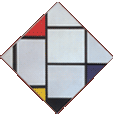
|
In 1908, Mondrian became fascinated with Theosophy, a form of religious mysticism based on Buddhist and Brahmin teachings. He expressed the cycle of reincarnation from birth to radiant bloom to decay in delicate watercolors and paintings of flowers. In 1911 Mondrian moved to Paris and discovered the work of Picasso and Braque. He embraced cubism and from 1912-14 his painting showed in abstract terms the themes that had filled his earlier work. In 1913 and 1914 he actively exhibited his cubist work which reflected the theosophical ideas in play of interacting forces and growth. At the outbreak of World War I, he was in Holland visiting his sick father and was obliged to stay there until the war ended in 1919. The works he painted during this four year period showed the influence of his years in Paris, as well as a new simplicity of line and color. |
|
|

Lozenge composition, 1924/tableau no.IV. lozangique pyramidal, 1925 with red, blue, yellow and black, 1924/1925
|
|||
|
|
| ← | Page | → |
| © 2002—2025 Mondrian/Holtzman Trust. All rights reserved. | Web Design by Enterprise Computer, LLC |